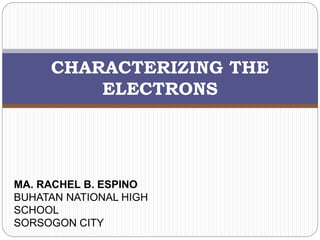
Characterizing Electrons
- 1. CHARACTERIZING THE ELECTRONS MA. RACHEL B. ESPINO BUHATAN NATIONAL HIGH SCHOOL SORSOGON CITY
- 2. The detailed knowledge of electron behaviour is essential since the characteristics of an element depends on the electron arrangement.
- 3. Atomic Orbital An atomic orbital is the volume or region of space around the nucleus where the electron being described is most likely to be found.
- 4. Each atomic orbital is characterized by: Energy Shape Orientation in space Direction of electron spin
- 5. Energy The electron energy relates to the size of the atomic orbital. The farther the distance of the electron from nucleus, the higher the distance of the electron from the nucleus, the bigger is the size of the atomic orbital and greater is its energy. HYDROGEN LITHIU M SODIU M POTASSIU
- 6. The main energy level (designated by the number “n”) where the orbital is found is designated by numbers (n = 1, 2, 3, 4, 5, 6, 7) or letters (K, L, M, N, O, P, Q). The number n is often referred to as principal quantum number. So far, all known elements have only enough electrons to occupy 7 main energy levels. n = 1 2 3 4 5 6 7 K L M N O P Q
- 7. Shapes There are four different kinds of atomic orbital based on shapes. Each kind is distinguished by a second quantum number designated by l. The quantum number l could take values from zero to n - 1. They are referred to as s ( l = 0), p ( l = 1), d ( l = 2) and f ( l = 3). These kinds of orbital (s,p,d,f ) are referred to as sublevels in each main energy level.
- 8. The main energy level in an atom actually consists of sublevels of energy. It means that although a number of electrons may be found in the same main energy level, they may actually be found in different sublevels of energy. It means, electrons in a particular main energy level do not really possess the same amount of energy.
- 10. Orientation in Space and Direction of Electron Spin
- 11. Pauli’s Exclusion Principle Pauli’s Exclusion Principle states that an orbital cannot hold more than 2 electrons (Wolfgang Pauli, 1925)
- 12. The Pauli’s Exclusion Principle is based on the following theories: 1. An electron exhibits a spin: clockwise or counterclockwise .
- 13. 2. When 2 electrons of opposite spins are spinning or rapidly whirling in space, they set up opposite magnetic fields which attracts one another. This explains why only 2 electrons can occupy the same orbital. Electrons with the same spin repel each other.
- 14. 3. A third electron will spin in a direction similar to either one of the two electrons in an orbital, as a result it will be repelled or pushed away by the electron with same spin.
- 15. Aufbau Principle Aufbau Principle states that as soon as an energy level is filled up with electrons, any additional electron is thrown to the next outer or higher energy level. (formulated by Neils Bohr and Wolfgang Pauli in the 1920s).
- 17. Hund’s Rule Hund’s Rule states that electrons occupy separate orbital in the same subshell with parallel spins first before pairing (Friedrich Hund, 1927)
- 19. The number or distribution or arrangement of electrons in the energy levels of a particular atom of an element. Example is the electron configuration of helium demonstrated below: 1 2 Main Energy level Orbital/ sublevel No. of electron in the sublevel
- 20. We use the periodic table to identify the main energy levels and sublevels
- 22. From the electron configuration, we can now presume the arrangement of the electrons in an element. For xample sodium.
- 24. References: Chemistry: Science and Technology Textbook for Third Year. Quezon City: Vibal Publishing House, 2009. Chemistry Textbook in Science and Technology Third Year. Quezon City: SD Publications, Inc., 2001. www.wikipedia.com
Editor's Notes
- What is the relationship between the number of electrons to the size of the atom?
- Review the result of flame test. What do the colors in the slide represent?
- Aufbau is a German noun that means construction or "building-up". The Aufbau principle is sometimes called the building-up principle or the Aufbau rule.
- What do you think do the superscript 2 and subscript 1 in He symbol stands for?
- What does the “n” stands for? For answer, review on the concept of electron energy in this presentation.
- What do the arrows represent?
